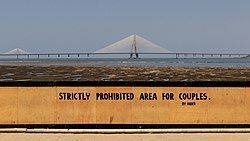The history of Mumbai can be traced back to 600 BC, with evidence of the first known settlement of the Harrappan civilization discovered in the region.[ citation needed ]
| History of India |
|---|
 |
| Timeline |
The history of Mumbai can be traced back to 600 BC, with evidence of the first known settlement of the Harrappan civilization discovered in the region.[ citation needed ]


| | This section needs expansion. You can help by adding to it. (July 2021) |
